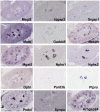Defining the molecular character of the developing and adult kidney podocyte
- PMID: 21931791
- PMCID: PMC3169617
- DOI: 10.1371/journal.pone.0024640
Defining the molecular character of the developing and adult kidney podocyte
Abstract
Background: The podocyte is a remarkable cell type, which encases the capillaries of the kidney glomerulus. Although mesodermal in origin it sends out axonal like projections that wrap around the capillaries. These extend yet finer projections, the foot processes, which interdigitate, leaving between them the slit diaphragms, through which the glomerular filtrate must pass. The podocytes are a subject of keen interest because of their key roles in kidney development and disease.
Methodology/principal findings: In this report we identified and characterized a novel transgenic mouse line, MafB-GFP, which specifically marked the kidney podocytes from a very early stage of development. These mice were then used to facilitate the fluorescent activated cell sorting based purification of podocytes from embryos at E13.5 and E15.5, as well as adults. Microarrays were then used to globally define the gene expression states of podocytes at these different developmental stages. A remarkable picture emerged, identifying the multiple sets of genes that establish the neuronal, muscle, and phagocytic properties of podocytes. The complete combinatorial code of transcription factors that create the podocyte was characterized, and the global lists of growth factors and receptors they express were defined.
Conclusions/significance: The complete molecular character of the in vivo podocyte is established for the first time. The active molecular functions and biological processes further define their unique combination of features. The results provide a resource atlas of gene expression patterns of developing and adult podocytes that will help to guide further research of these incredible cells.
Conflict of interest statement
Figures









References
-
- Pavenstadt H, Kriz W, Kretzler M. Cell biology of the glomerular podocyte. Physiol Rev. 2003;83:253–307. - PubMed
-
- Dijkman H, Smeets B, van der Laak J, Steenbergen E, Wetzels J. The parietal epithelial cell is crucially involved in human idiopathic focal segmental glomerulosclerosis. Kidney Int. 2005;68:1562–1572. - PubMed
Publication types
MeSH terms
Grants and funding
LinkOut - more resources
Full Text Sources
Other Literature Sources
Molecular Biology Databases

